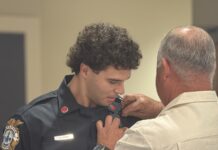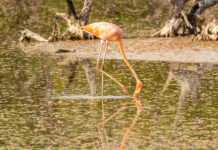Just recently, officials removed an 11-foot crocodile from Key Largo. And last week, Marathon resident Jim Tashijan called The Weekly to report seeing two different crocodiles in the Sombrero Beach neighborhood over a period of three days between Nov. 30 and Dec. 2.
“One was about six feet long and another looked a little smaller, maybe five feet long,” Tashijan said.
With the recent increase of American Crocodiles numbers in the Upper Keys, folks in the Middle Keys are keeping a careful watch. While crocodile sightings aren’t exactly everyday occurrences in Marathon, neither are they rare. Residents have reported seeing them on the golf course, near the country club, in the canal behind Manor Lane and also near the fishing pier at Sombrero Beach.
“There have been crocodiles in the Keys for a long time. They’re more common in the Upper Keys, but they have been spotted as far south as Big Pine Key and the Dry Tortugas,” said Lindsey Hord, the Fish and Wildlife Conservation Commission’s crocodile response coordinator. “And it’s quite likely the numbers will increase because of the growing population of crocodiles in the Everglades National Park.”
For the crocs, it’s just a short jaunt across Florida Bay to the Upper Keys; the animals have to travel a bit further to reach Marathon. Which means the Middle Keys is probably less likely to see the same numbers of crocs, however the animals have a tendency to return to the same spot over and over again.
“When we remove a crocodile, we take it to the Everglades and release it. While we’re transporting the animal we put magnets on it … so they don’t remember where they came from,” said FWC officer Robert Dube. In theory, the magnets will disturb the animal’s sense of direction, preventing it from finding its way back to the trouble zone.
[box]Living with crocodiles
• Closely supervise children when they are playing in and around water.
• Crocodiles are most active at night, between dusk and dawn. Swim only during daylight hours.
• Do not allow pets to swim or exercise in water that may contain crocodiles. Dogs are more susceptible to being bitten than humans because they resemble the natural prey of crocodiles.
• Use fences or other barriers to separate pets and people from crocodiles.
• Never feed or entice crocodiles. If the animal is spotted in the canal, curtail fish cleaning and don’t allow scraps or carcasses to go into the water.
• Warn others about the presence of crocodiles.
• Observe and photograph crocodiles from a distance.
excerpt from the FWC’s Living With Crocodiles brochure
[/box]Catching and moving a crocodile is no easy matter. Although the FWC reviews each case independently, policy dictates it remove animals only longer than 9 feet long. If the crocodile is smaller, the situation must be reviewed.
“It depends on the circumstance, the size of the animal,” Hord said, “and if it presents some danger to people.”
Hord said the most vulnerable to a crocodile attack are pets because they resemble the small prey crocodiles typically target. Although American Crocodiles normally eat fish, their diet is supplemented with birds, turtles, snails and frogs. And the pets are most vulnerable in the hours just after nightfall, especially on a moonless night, when crocodiles are most likely to feed.
The American Crocodile was listed as endangered in 1975 at a time when the population numbered about 300. Since then it’s grown to an estimated 2,000 in South Florida, although the cold winter of 2010 is thought to have reduced that number. In Florida, the average adult male is almost 14 feet long.
Not to worry, said Hord.
“With the proper precautions and the proper attitude, we can coexist with the crocodile.”





















